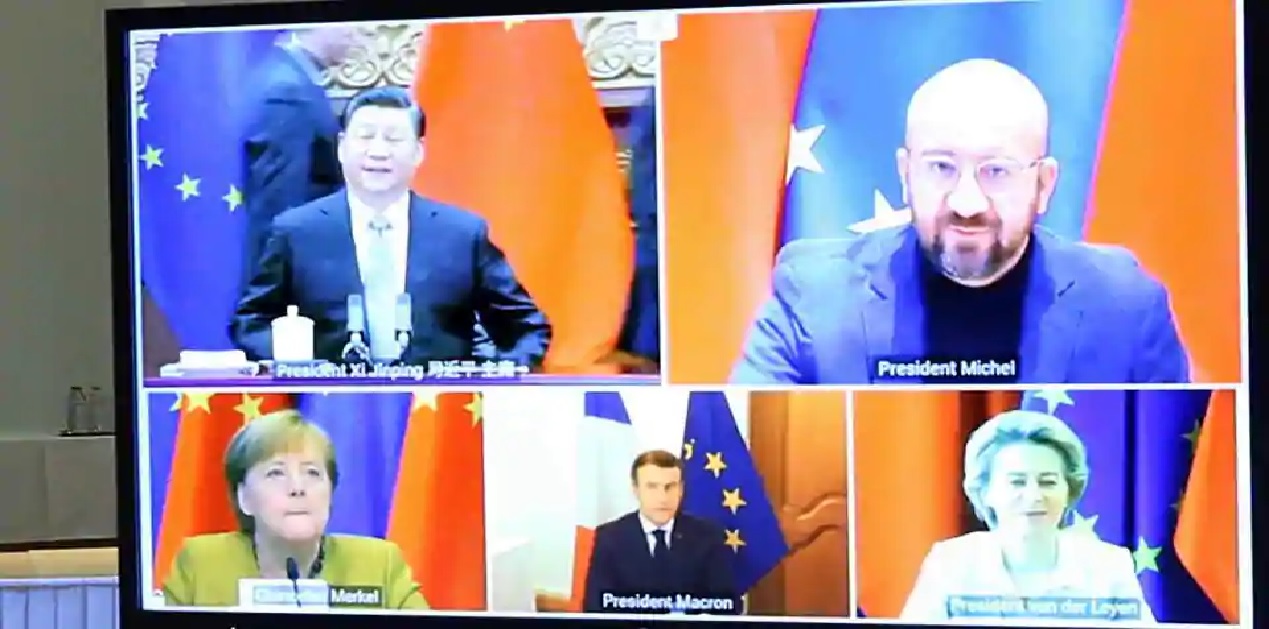The EU and China announced a Comprehensive Agreement on Investment on 30th December. The announcement comes less than a month before the inauguration of the Biden Presidency. The development shows a rift opening up between EU and US positions even before the contours of the new Administration’s China policy have become clear. The agreement negotiated by the European Commission will have to be approved by the European Parliament and the EU Council. This process will take some time. The EU went ahead with the deal despite a cautionary tweet from the incoming US National Security Advisor Jake Sullivan.
The EU’s position is that the deal was under discussion for some time. Chancellor Angela Merkel had set the year-end deadline for the agreement to be completed. According to a Financial Times article, Mr. Valdis Dombrovskis, the EU’s trade commissioner said that ‘the deal contained the “most ambitious outcomes that China has ever agreed with a third country” in terms of market access, fair competition, and sustainable development.’1 He added that the deal represented a “leveling up” with the US which secured market access and level playing field commitments from China in the Phase 1 deal negotiated by the Trump administration.’2
According to a European Commission press release, the cumulative EU foreign direct investment (FDI) flows from the EU to China over the last 20 years have reached more than Euro 140 billion. For Chinese FDI into the EU, the figure is almost Euro 120 billion.3 The EC statement mentioned that the ‘EU-China Comprehensive Agreement on Investment (CAI) will be the most ambitious agreement that China has ever concluded with a third country.’ It stated further that ‘The CAI will ensure that EU investors achieve better access to a fast-growing 1.4 billion consumer market, and that they compete on a better level playing field in China.’4 It added that the CAI binds China’s liberalization of investments over the last 20 years and, in that way, it prevents backsliding.’5 It rested that claim on a dispute resolution mechanism in CAI in case of breach of commitments.
According to the European Commission press release, China has made comprehensive commitments with only very limited exclusions in the manufacturing sector, which accounts for roughly half of the EU’s FDI.6 China has also agreed to remove and phase out joint venture requirements in the automotive sector. China will commit market access for new energy vehicles. It has agreed to remove joint venture requirements and foreign equity caps for banking, trading in securities and insurance (including reinsurance), as well as asset management. It will also remove joint venture requirements for private hospitals. It has agreed not to introduce new restrictions in R&D (biological resources) and to give to the EU benefit of any lifting of current restrictions in this area in the future.
EU has secured a lifting of the Chinese ban for foreign investment in cloud services. EU can invest subject to a 50 % equity cap. China has also agreed to bind market access for computer services.7 The EU can also invest in international maritime transport, air transport-related services, and business services.8 EU has secured a Chinese agreement against forced technology transfers.9 The agreement prohibits ‘several types of investment requirements that compel transfer of technology to a joint venture partner.
Despite its claims, the EU has been less than successful in imposing labour and environment standards, where the Chinese commitment is limited to ‘not to lower the standards of protection in order to attract investment’10. Given the fact that the existing Chinese standards in these two fields may be substantially lower than EU levels, this amounts to simply freezing the present asymmetry. The EU press release also mentions the Chinese commitment to ‘effectively implement the Paris Agreement on climate’.11 Since Paris Agreement does not include any mandatory commitments, this again may not amount to much. Both the EU and China have announced more ambitious goals since. While the EU has agreed to achieve net-zero emission by 2050, China has agreed to reach this milestone by 2060.
President-elect Biden’s National Security Advisor Jake Sullivan had tweeted before the agreement that the new administration “would welcome early consultations with our European partners on our common concerns about China’s economic practices”.12 The tweet was probably the reason why the meeting of the EU Trade Commissioner Valdis Dombrovskis’s meeting with the Chinese Vice Premier Liu He on December 22nd was canceled.13 However, the agreement went through. Matt Pottinger, President Trump’s Deputy National Security Advisor mentioned that ‘Leaders in both US political parties and across the US government are perplexed and stunned’ by the conclusion of the investment deal on the eve of the Presidential transition in the US.14 After the agreement was signed, a Biden transition official said that the new administration “looks forward to consulting with the EU on a coordinated approach to China’s unfair economic practices and other important challenges.”15
There have been dissenting voices in the EU. Franck Riester, France’s junior trade minister said that ‘Paris would block the deal if the CAI did not force Beijing to abolish forced labour.16 China has only committed to making “continued and sustained efforts” to ratify the relevant ILO conventions.17 The Polish Foreign Minister Zbigniew Rau called for “more consultations and transparency” to bring “our transatlantic allies on board.”18
While the EU describes its investment agreement as a “leveling up” with the US which has secured market access in China under the Phase 1 deal negotiated by the Trump administration, how much has the US gained from its agreement? Out of a total commitment of $ 159 billion made by China to purchase from the US in 2020, the amount purchased through November was $ 82 billion. What does the agreement mean for India? There is a fundamental difference in the geo-political context of India and EU. The latter does not share a border with China. China has secured investment deal with EU without accepting environmental and labour conditions insisted upon by the EU. 19
Endnotes
- Financial Times, EU and China agree new investment treaty, December 30 2020
- Ibid
- European Commission Press Release, Key elements of the EU-China Comprehensive Agreement on Investment, 30 December 2020, www.ec.europa.eu
- Ibid
- Ibid
- Ibid
- Ibid.
- Ibid
- Ibid
- Ibid
- Ibid
- Financial Times, China sees EU investment deal as diplomatic coup after US battles, January 1, 2021
- Wall Street Journal, Biden, Meet Your Frenemies in Europe, December 27, 2020
- Ibid
- Ibid
- Ibid.
- Ibid
- Ibid
- Wall Street Journal, Trump’s Trade War Will Be Left for Biden to Win, January 3, 2021
(The paper is the author’s individual scholastic articulation. The author certifies that the article/paper is original in content, unpublished and it has not been submitted for publication/web upload elsewhere, and that the facts and figures quoted are duly referenced, as needed, and are believed to be correct). (The paper does not necessarily represent the organisational stance... More >>
Image Source: https://www.hindustantimes.com/rf/image_size_960x540/HT/p2/2020/12/30/Pictures/open-market-china-seal-investment-agreement-chinese_9466fcf2-4aab-11eb-b097-bed98ba4ca79.jpg










Post new comment